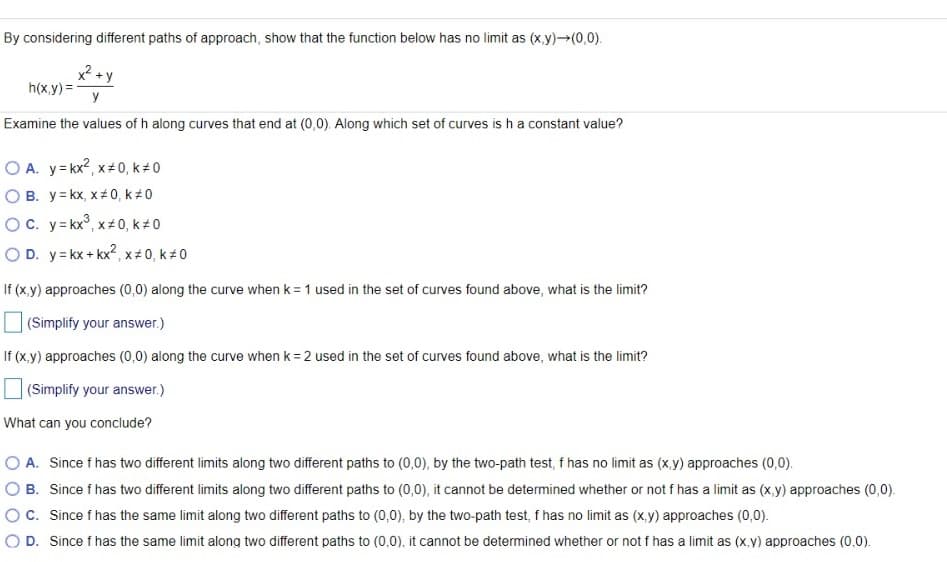two-path test, f has no limit as (x,y) approaches (0,0).
Advanced Engineering Mathematics
10th Edition
ISBN:9780470458365
Author:Erwin Kreyszig
Publisher:Erwin Kreyszig
Chapter2: Second-order Linear Odes
Section: Chapter Questions
Problem 1RQ
Related questions
Question
Please explain and faster

Transcribed Image Text:By considering different paths of approach, show that the function below has no limit as (x,y)→(0,0).
x? +y
h(x,y) =
y
Examine the values of h along curves that end at (0,0). Along which set of curves is ha constant value?
O A. y= kx?, x+0, k 0
O B. y= kx, x#0, k #0
OC. y= kx°, x ± 0, k ± 0
O D. y= kx + kx?, x 0, k 0
If (x,y) approaches (0,0) along the curve when k = 1 used in the set of curves found above, what is the limit?
(Simplify your answer.)
If (x.y) approaches (0,0) along the curve when k = 2 used in the set of curves found above, what is the limit?
(Simplify your answer.)
What can you conclude?
O A. Since f has two different limits along two different paths to (0,0), by the two-path test, f has no limit as (x,y) approaches (0,0).
O B. Since f has two different limits along two different paths to (0,0), it cannot be determined whether or not f has a limit as (x,y) approaches (0,0).
OC. Since f has the same limit along two different paths to (0,0), by the two-path test, f has no limit as (x,y) approaches (0,0).
O D. Since f has the same limit along two different paths to (0.0), it cannot be determined whether or not f has a limit as (x,y) approaches (0,0).
Expert Solution
This question has been solved!
Explore an expertly crafted, step-by-step solution for a thorough understanding of key concepts.
This is a popular solution!
Trending now
This is a popular solution!
Step by step
Solved in 2 steps with 1 images

Knowledge Booster
Learn more about
Need a deep-dive on the concept behind this application? Look no further. Learn more about this topic, advanced-math and related others by exploring similar questions and additional content below.Recommended textbooks for you

Advanced Engineering Mathematics
Advanced Math
ISBN:
9780470458365
Author:
Erwin Kreyszig
Publisher:
Wiley, John & Sons, Incorporated

Numerical Methods for Engineers
Advanced Math
ISBN:
9780073397924
Author:
Steven C. Chapra Dr., Raymond P. Canale
Publisher:
McGraw-Hill Education

Introductory Mathematics for Engineering Applicat…
Advanced Math
ISBN:
9781118141809
Author:
Nathan Klingbeil
Publisher:
WILEY

Advanced Engineering Mathematics
Advanced Math
ISBN:
9780470458365
Author:
Erwin Kreyszig
Publisher:
Wiley, John & Sons, Incorporated

Numerical Methods for Engineers
Advanced Math
ISBN:
9780073397924
Author:
Steven C. Chapra Dr., Raymond P. Canale
Publisher:
McGraw-Hill Education

Introductory Mathematics for Engineering Applicat…
Advanced Math
ISBN:
9781118141809
Author:
Nathan Klingbeil
Publisher:
WILEY

Mathematics For Machine Technology
Advanced Math
ISBN:
9781337798310
Author:
Peterson, John.
Publisher:
Cengage Learning,

